Osaka, Kyoto or Kobe?
We spent quite some time deliberating on whether we should next stay in Osaka, Kyoto or Kobe. There were many options to choose from. We had to take into account that we were going to be staying over a weekend and this always makes a difference to the price of accommodation.
Most of these places are weekend destinations for locals travelling from Tokyo.
In the end, we decided that Kyoto was priced out of the ballpark (even more so than many of the other cities). Kobe was just a bit far out and that would have meant a lot more travelling between the cities, even with an excellent train system. Osaka just seems to meet our needs halfway so that’s where we decided to go for our next stopover.
There is still a lot to see and do in both Osaka and Kyoto and transport between the two cities seemed relatively easy so it was going to achievable to Kyoto on day excursions from Osaka.
It was just a little over 2 hours on the Bullet train from Hiroshima to Osaka.
History of Osaka
Osaka is the second largest city in Japan and is a major economic hub for the country. It has over 19 million people living in within its wards.
Historically, Osaka was a merchant city and is known as the nation’s kitchen as it served as a centre for the rice trade.
Accommodation
We again stayed at WBF Hotel (2nd time staying at this hotel chain in Japan). We paid $449nz for 3 nights (without breakfast). Our choices in the accommodation are based on location and price. We read the reviews and form our own opinion. We take into account that you get what you pay for. The WBF Hotel was conveniently located close to public transport which makes it a lot easier and cheaper than others further out. You may pay less to stay in an outlying area, but more in transport costs and time.
Things to See in Osaka
We wanted to hit the ground running so we wasted no time and headed straight out and started to look around the city of Osaka.
Shotengai
We have discovered that covered shopping arcades are huge throughout Japan. Osaka is no different.
Called Shotengai, these covered arcades stretch for km’s in all directions. Some have high-end shopping labels, while others have run-of-the-mill local goods. We wandered down the massive Shinsaibashi-suji which seemed to go on forever.
Ebisu-Bashi Bridge
We crossed over the iconic Ebisu-Bashi Bridge which spans the Dotombori Canel. We still don’t know why this is so iconic, it was just a bridge. Maybe we missed something!!
The original Ebisu-Bashi Bridge was built around the same time the digging out of the Dotombori River (canal) it passes over and was completed, in 1615. The current Ebisu-Bashi was completed in 2007 and was built to replace the former bridge of 1925. I’m wondering if that is why it wasn’t overly spectacular. The hundreds of tourists that were standing on the bridge for an icon photo certainly thought that it was pretty special though.
Dotombori
The entire Dotombori area is the most symbolic and well-known in Osaka. It is an area of ordered chaos with a maddening mix of people, lights, sounds and smells which assaults your senses.
The name comes from the Dotomobori River which is, in fact, a canal that runs through the middle of the district.
We spent a considerable amount of time during our evenings in Osaka, wandering through the many covered Shotengai (shopping arcades) that all link up together. Just when you think that you are getting hopelessly lost, we always seem to pop out by the Dotombori River.
Takoyaki
We thought that we had better try the local delicacy Takoyaki, which is fried Octopus Balls. This is best eaten sitting beside the Dotombori River which is also the best spot for some people watching.
Takoyaki is runny batter fried balls with a chunk of octopus inside. Just make sure they aren’t too hot when you take a bite – Scotty scored a burnt lip as he delicately bit into his first one.
The runny batter can certainly inflict a lot of pain as it runs down your lips and chin.
We also became fans of the vendor machine ordered meals. It took us a while to work out how these actually worked when we were in Sth Korea. They are just as popular here in Japan. Simply order your meal by pushing the appropriate button (thankfully next to a descriptive photo), put in the correct amount of money and then take the ticket up to the chef at the counter of the restaurant. That way, they cut down on staff, they’re not handling money and it is vendor machine to table in no time.
It’s a very affordable, quick and tasty way to eat dinner.
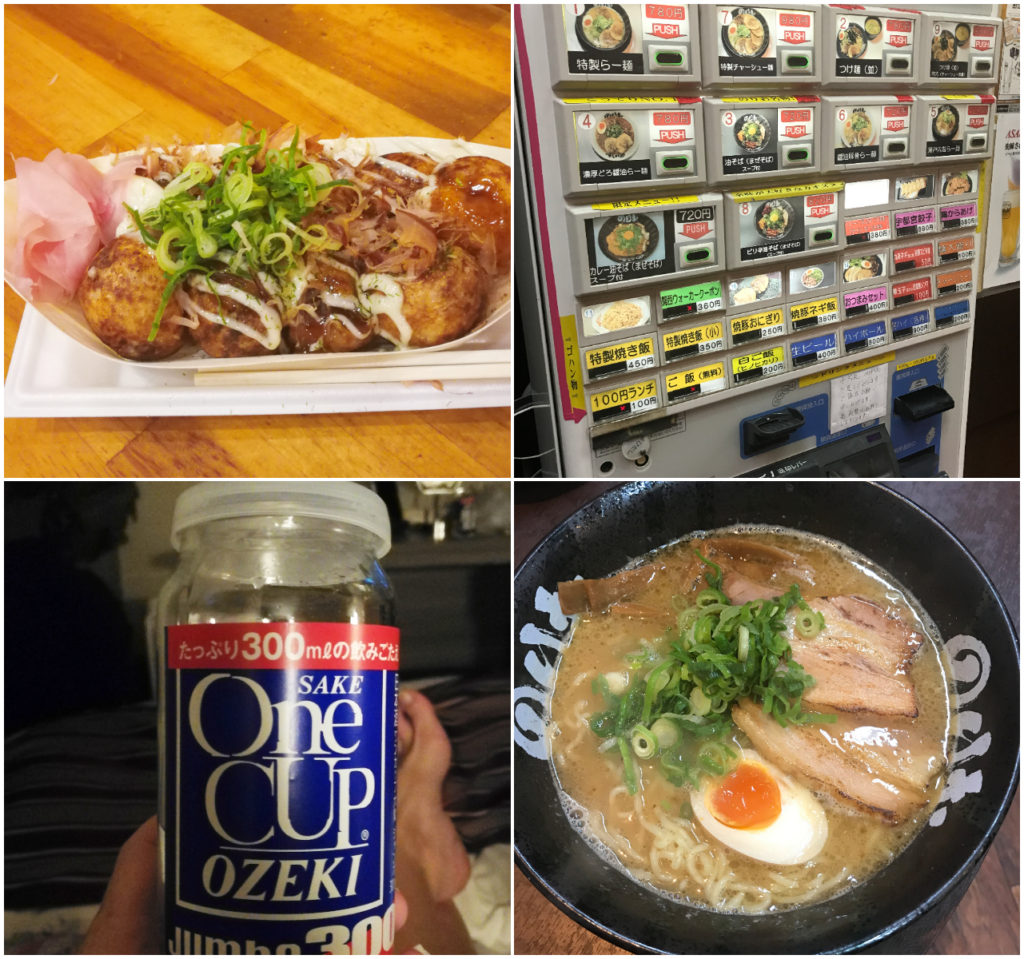
Takoyaki (Octopus Balls – top left), ordering meals via Vendor Machine, yummy Ramon noodles and our speciality – One Cup Sake from the 7/11 store
Osaka Castle and Park
We headed early to Osaka Castle and park. We weren’t quite early enough. As the castle looked just like the castle we visited in Hiroshima, we decided that the surrounding grounds and park would suffice.
We were quite pleased we made the decision not to venture inside as tour party after tour party had already descended on the castle and there was a considerable queue to get in. The castle itself opens at 9 am and at 8.45am there was already quite a long queue.
Another reason we weren’t keen on paying and queueing to enter the castle is that there isn’t very much left of the original castle construction.
The first Osaka Castle stood on this site and construction commenced in the 1580’s. It was the largest castle in Japan at the time. In 1615 the castle was attacked and destroyed. It was rebuilt but was struck by lightning in 1665 and burnt to the ground. By this stage, you would start to think that it was somewhat jinxed! It wasn’t until as late as 1931 that the present reconstruction of the castle tower was built. Surviving the city-wide air raids of World War II, it was fully restored to its current glory in 1997.
It is now entirely modern on the inside and even features an elevator for easier access. If I’m going to be paying to enter a castle, I would rather see it in its former glory. There is apparently an informative museum about the castle’s history and the surrounding area.
Osaka Castle Park
Now the grounds surrounding the castle was very impressive. The entire park covers about 2 square km and is surrounded by secondary citadels, gates, turrets and impressive stone walls and moats.
There is a lovely lawn garden with over 600 cherry trees and it offers quite a spectacular view of the castle.
Click on the link below for a video of our highlights of Osaka.
Kyoto
We had worked out that Kyoto is certainly within an acceptable distance for a day trip or two from Osaka.
This involved three trains and took us over an hour to get there. This was mainly due to the fact that Scotty had put us on a commuter train that stopped at every station. The more acceptable option is to get on the ‘Thunderbird’ train which is a ‘semi high-speed’ train which has limited stops (24-minute trip as opposed to 60-minutes). It is so hard to find a good navigator sometimes!!
Fushi-Inari Taisha Shrine
Our plan was to head straight to one of the most popular tourist destinations in Kyoto. Bearing in mind that it was a Saturday and we know that crowds swell at these places no matter what day of the week it is.
Fushi-Inari Taisha Shrine is located directly across the road from the train station. Because we were on the rather slower commuter train initially, we didn’t alight from our train until 9.45am.
Eeek, the entrance to the shrine was packed with people jostling to get in! We had read to make sure you head straight up the hill first and the crowds would start to diminish the further up the hill you go. As some tourists can’t make it all the way to the top, the information turned out to be true. The higher the climb the less amount of people.
This intriguing shrine was dedicated to the god of rice and sake in the 8th century. The magical, seemingly unending path of over 5,000 orange torii gates wind through the hills beyond the actual shrine. It makes for such great photos and it is difficult to get that perfect shot without hundreds of other snap-happy tourists.
Fushi-Inari Taisha is the most important of 40,000 shrines in Japan dedicated to the god of rice and sushi. Foxes are thought to be messengers, resulting in many fox statues across the shrine grounds.
Gion Area
I was particularly keen to visit the Gion area. This is the home of the traditional Geisha Girls.
The Gion district was built to accommodate travellers to the shrine but it evolved to become of the most exclusive and well-known geisha districts in all of Japan.
The term geisha means ‘artist’ or geiko (which is what they are known as in Gion) means ‘a woman of art’. They are Japanese women who study the ancient tradition of art, dance and singing. They are recognisable by their traditional costumes and white-faced make-up. Contrary to popular belief, geishas are not the Western equivalent of the prostitute.
Teahouses of Gion
Gion was a beautiful town, dotted with old-style Japanese houses. These are the traditional establishments where the modern-day businessmen are still entertained by geisha/geiko in a private and closed world manner and have done for centuries.
The evening’s entertainment may include cocktails, conversation and games. There is often traditional Japanese music, singing and dancing. We were there too early in the day to spot any of the geisha girls but we did catch a glimpse of a very young looking geisha on her way to an engagement.
We spent some time wandering the streets and alleys, trying to spot the elusive and private teahouses. Some had small signs outside but the majority of the buildings just looked like any residential or shop fronts. You would really need to be ‘in the know’ and mix in the appropriate circles to know where to go for your evening’s entertainment.
The river running through the town has many cherry blossom trees. There was no shortage of willing models walking about the river in traditional dress, posing for photo’s as they wandered along. It is also a popular place for wedding parties to have their pictures taken in the very photogenic surroundings.
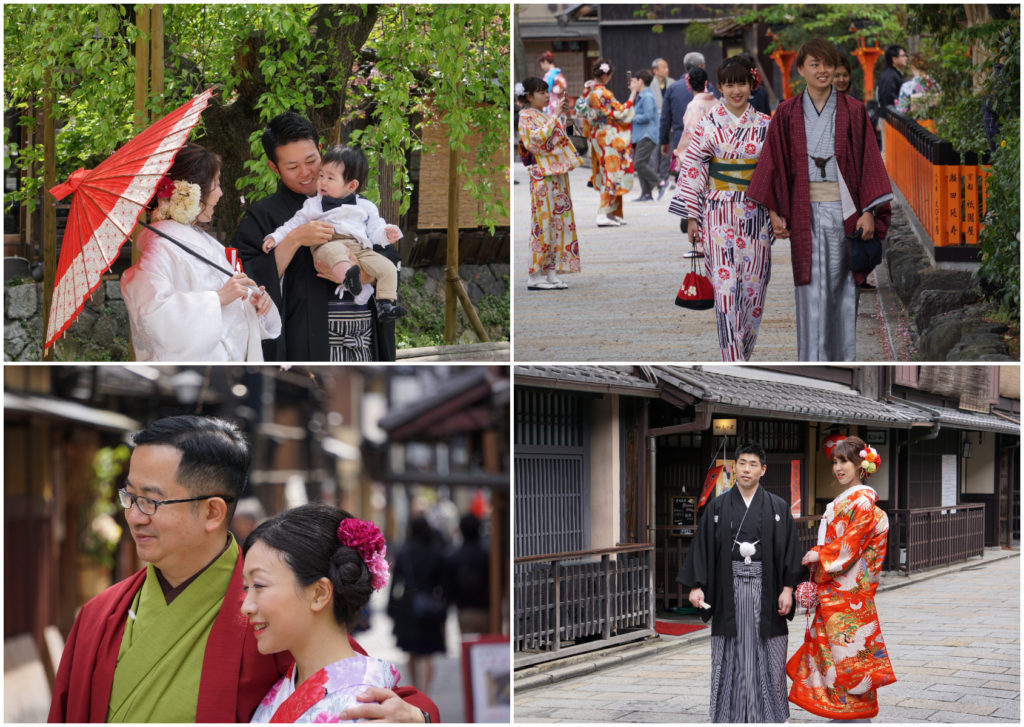
Although we were too early for the Geisha’s, there were plenty of traditional dress and weddings to watch
Gion also has many modern restaurants of all types, bars, clubs and betting shops. There are also a very large number of tourist-orientated businesses. It has become a major tourist hub and popular nightlife spot for locals.
Bamboo Forest, Arashiyama
This destination was rated as one of the ‘must do’ attractions for Kyoto. It is filled with temples and shrines, but the star attraction is the Arahiyama Bamboo Forest.
It was another train ride to get to Arashiyama and there were already a lot of tourists there who had arrived by the coach load.
The weather had decided to pack in and we were really in two minds as to whether we wanted to make the pilgrimage to the Bamboo Forest. It was a decent walk but we decided that we had come this far, we may as well make the journey.
We started off by walking to the Togetsukyo Bridge. A popular photo spot across the river but we didn’t think that it rated too highly, just a rather long bridge really.
As mentioned earlier, there are many temples en route to the forest, but we had seen so many temples to date, that we pressed on to reach the Bamboo Forest in what was becoming a rather heavy rain shower.
Entering the Bamboo Forest, the thick green bamboo stalks seem to continue endlessly in every direction. It gave a strange quality to the light and it took on an almost eerie atmosphere. Photo’s don’t really do it any justice and we don’t recall ever being emersed in such a dense grove of bamboo before.
I think that it would have been better later in the afternoon with the late afternoon sun shining through the growth but we are pleased we made the effort to wander through. It was just different to anything we’d seen in our travels.
Train Museum of Kyoto
We read the reviews of the Train Museum of Kyoto. It did appear that it was targeting children rather than adults. There was enough good feedback to warrant a visit though.
Now we are fans of travelling by train. Whether it is the super fast Bullet Trains or the modest sleeper trains, it is by far, our prefered mode of transport.
I was brought up in a ‘Railway Enthusiast’ household. Dad was an avid follower of all things trains, especially from the steam train era.
The Train Museum of Kyoto was an outstanding collection of trains and engines dating back to the 1880’s. The setup and displays were interactive for the kids to enjoy. There were displays of the many engines and carriages throughout the different decades. The first bullet train of Japan in 1964 still looked modern. This goes to show that the invention of the Bullet Train in Japan was ahead of its time.
Everything in this museum has been done on a grand scale. There were massive workshops used in the maintenance and restoration process. Just as impressive was a 20 bay ‘Roundhouse’ which is full of their massive collection of steam locomotives.
In total there are over 53 examples of carriages and engines on display. This includes steam, diesel, electrical, Shinkansen (Bullet Train), passenger and freight carriages.
Sidenote
My visit here was tinged with sadness and nostalgia. My Dad would have absolutely loved to have seen this museum. Never in his wildest dreams could he have ever imagined seeing such a collection in one place.
At the time of our visit, Dad was still in his Rest Home back in NZ. I was lucky enough to be able to have visited him one last time before his passing. We showed him our photos of this amazing place. Even with his body and brain wracked with dementia, he still managed to smile his way through our photos and stories of the things we had seen at this museum. I told him that we could have dropped him off there for a week and he still would not have seen enough.
May he now rest in peace. I can only hope that they have steam engines in heaven…….. this one’s for you Dad.
Click on the link below for our highlights of Kyoto.
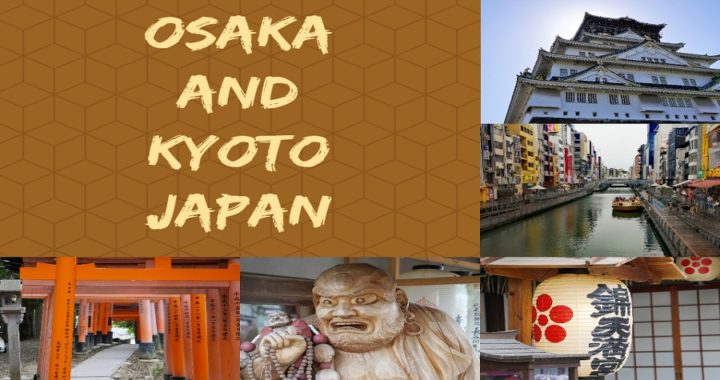
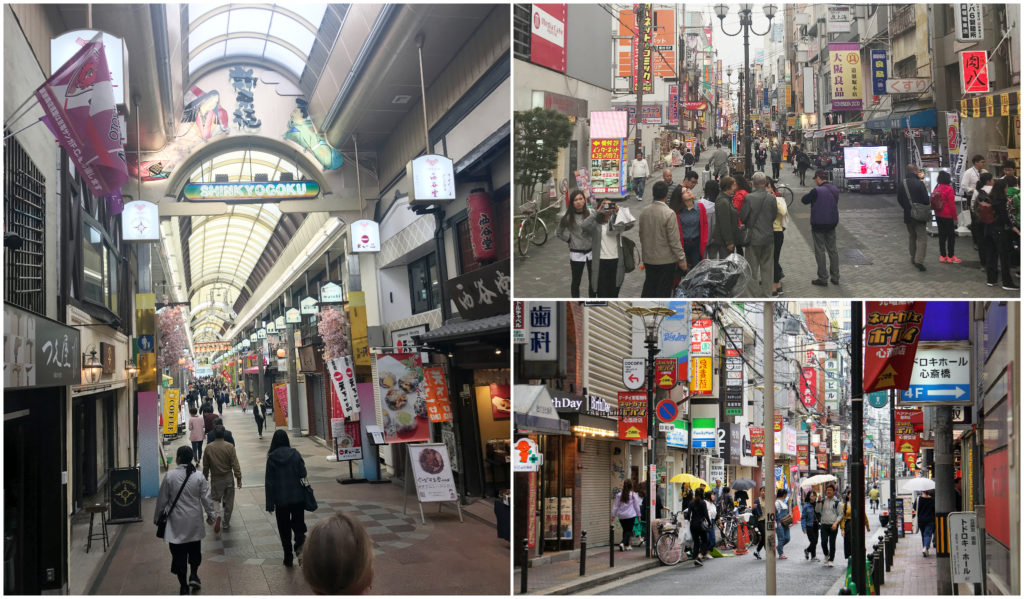
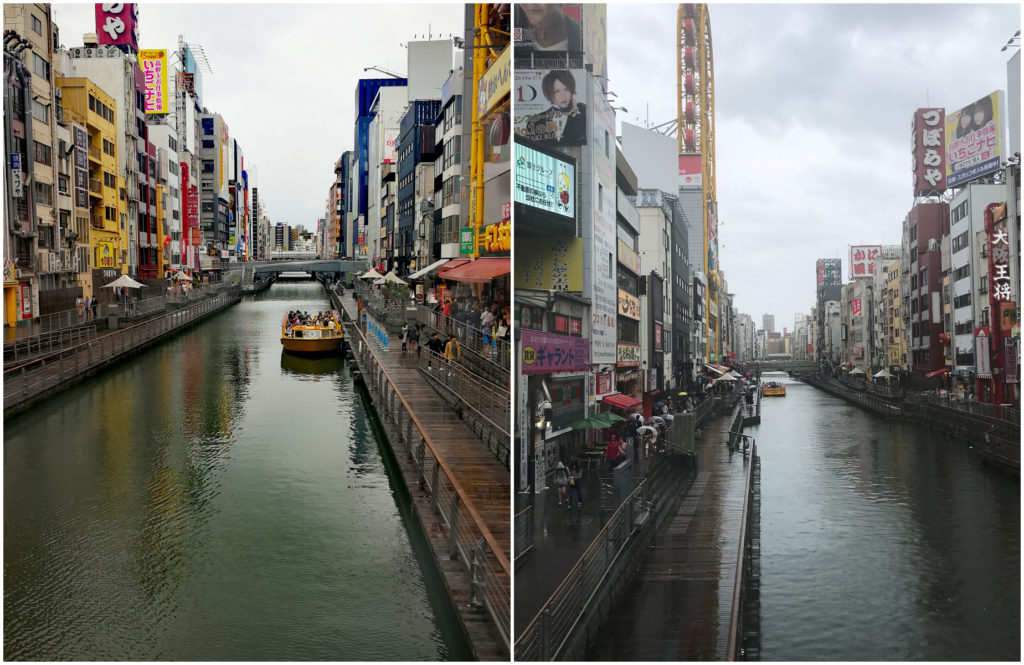
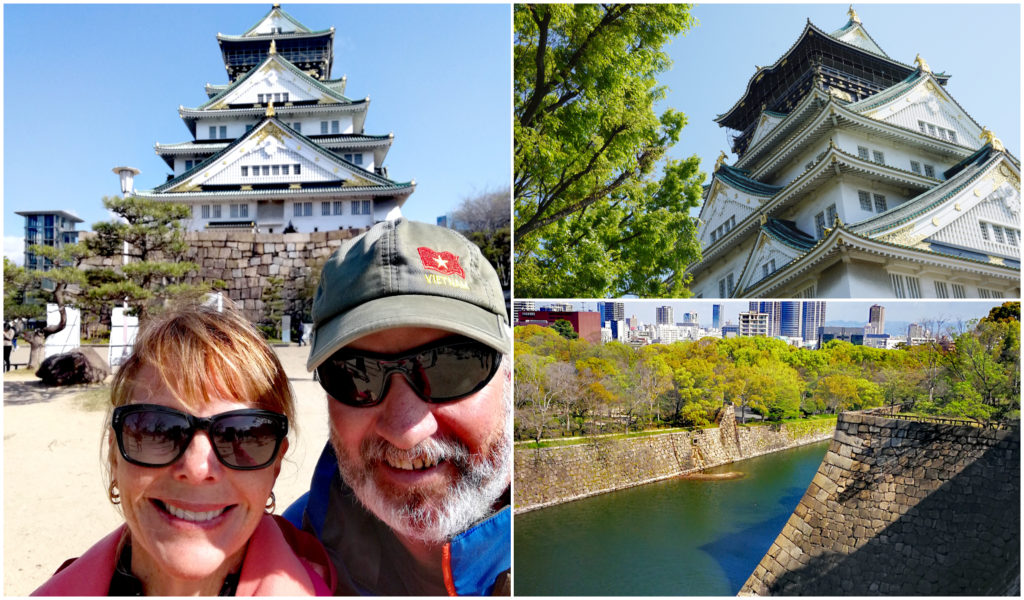
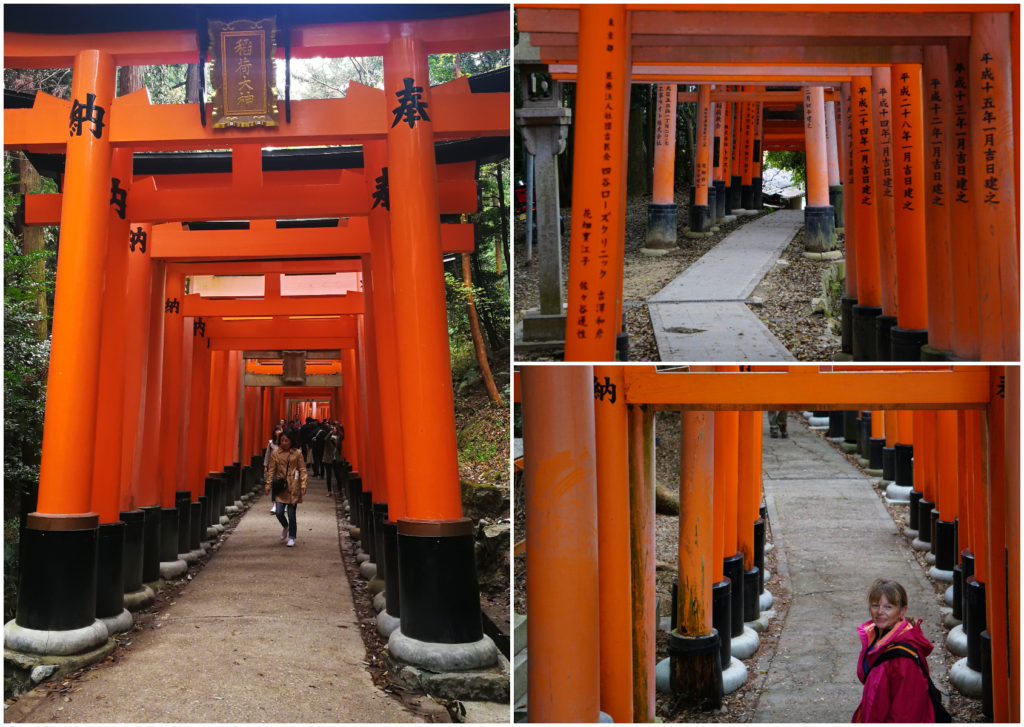
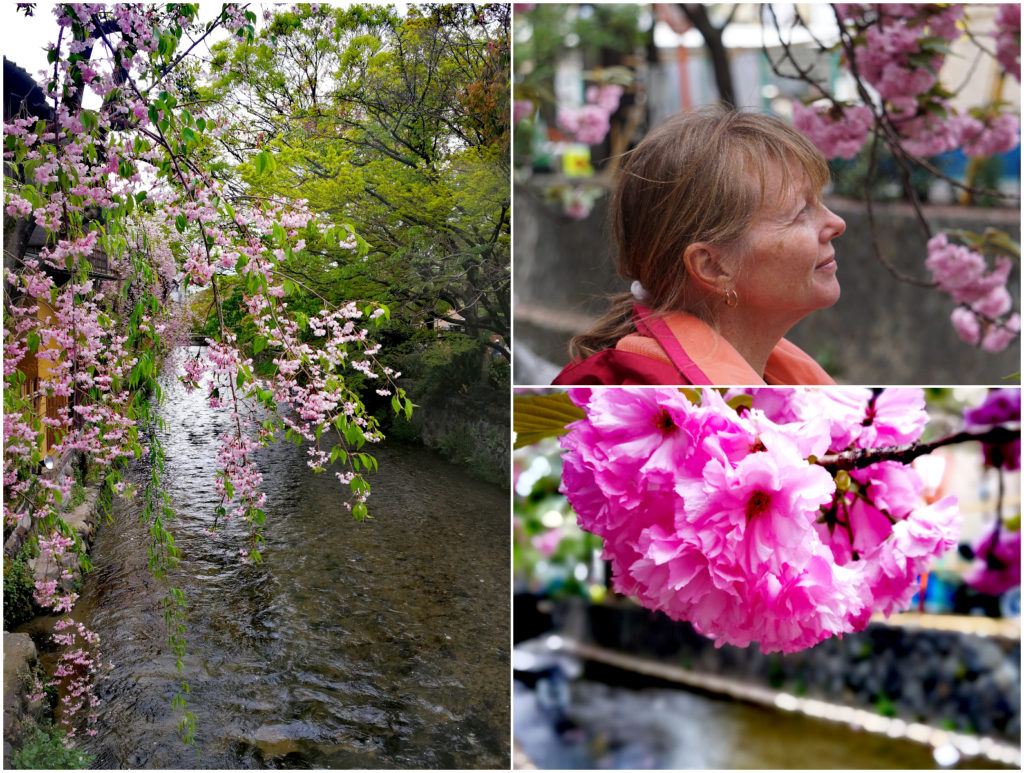
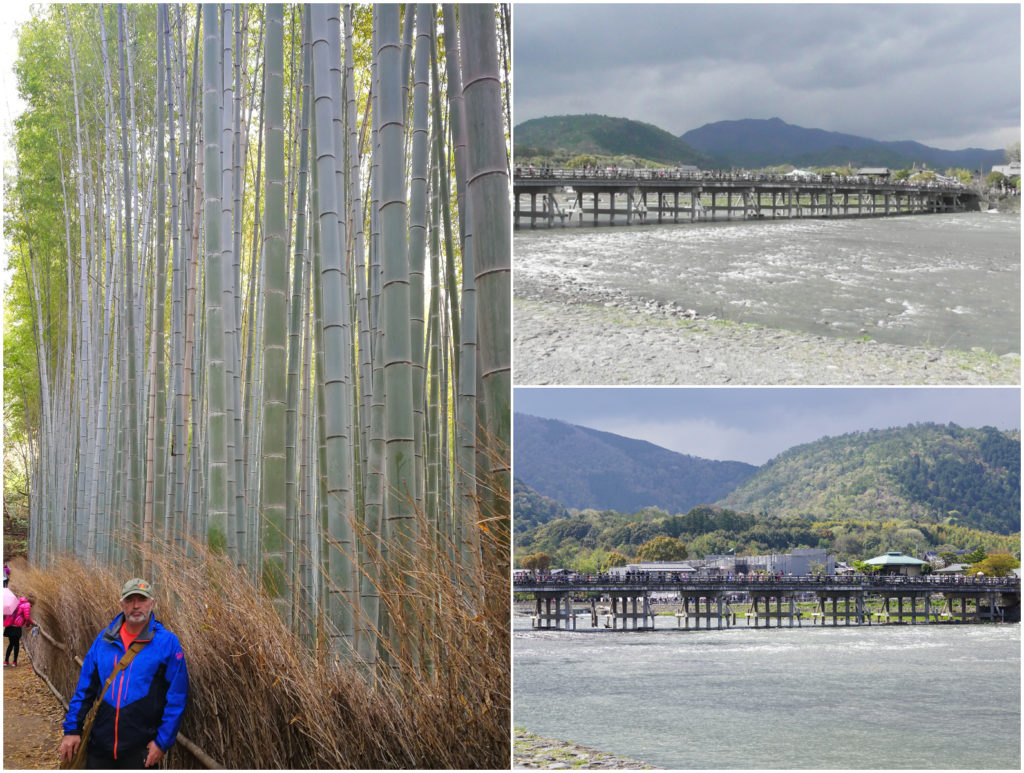
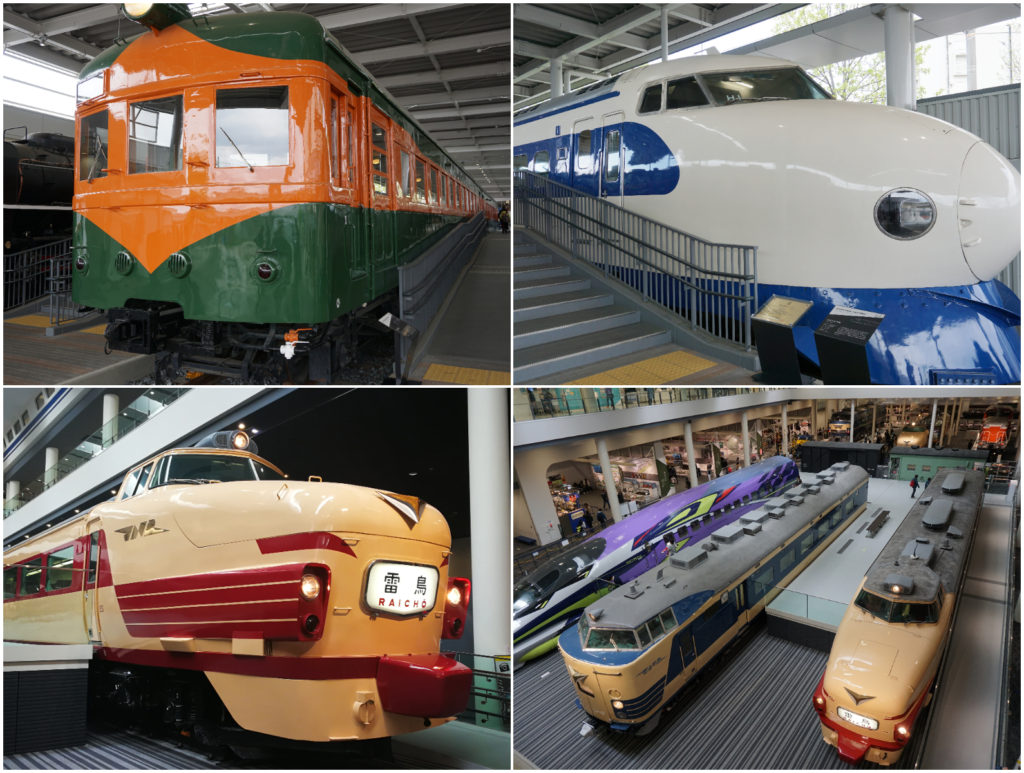
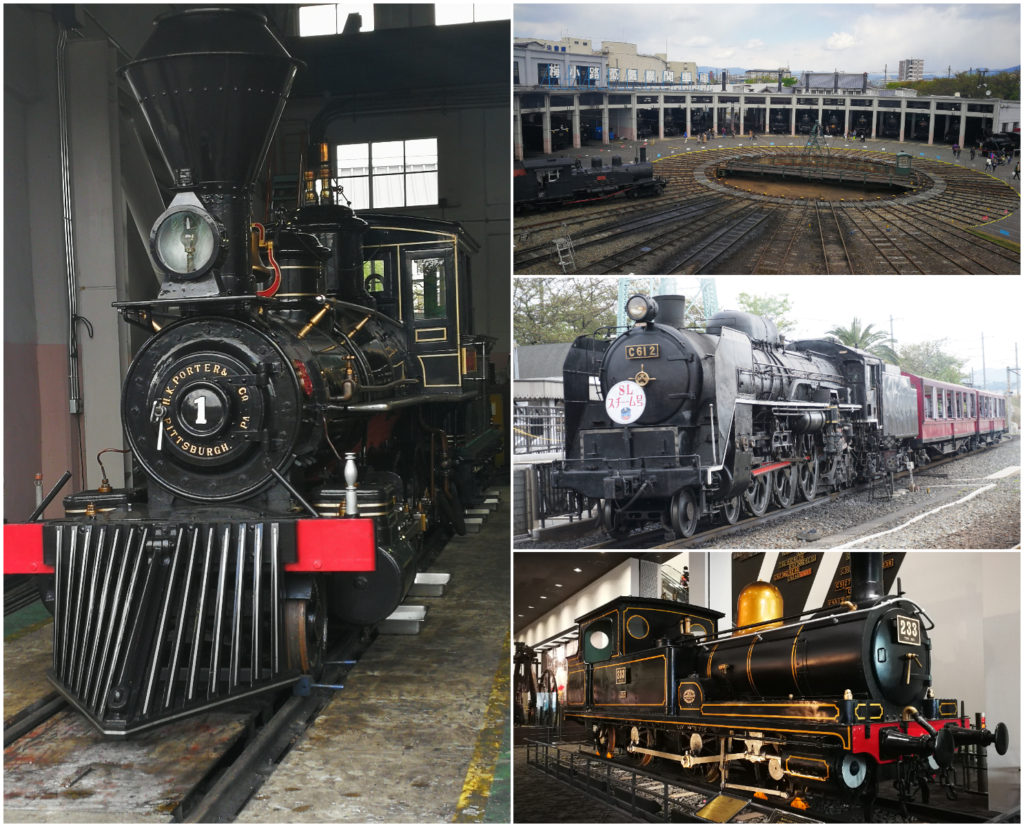
Thanks so much your post are so interesting and information. So sorry to hear about your Dad, my thoughts and prayers at with you.
We are going to Japan and have one day stops from the ship so this is really helping us.
Hope your travels take you to Canada some day would love to meet up with you again.
I have not answered all your posts sorry but read them, will be wonderful memories for you for sure.
Where is your next sitting position. How are the bamboo briefs going (lol) Travel safe hugs.
Thanks for your comments Ruth. Our travels are going well and we are loving our house sit in Kathmandu. The people and culture are amazing. Yes, my bamboo undies are still going strong – thanks for asking….lol. We would love to visit Canada one day and it is certainly on our list. You will be at the top of our list for a visit.